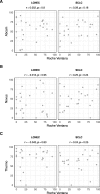Comparison of four DLL3 antibodies performance in high grade neuroendocrine lung tumor samples and cell cultures
- PMID: 31109352
- PMCID: PMC6528329
- DOI: 10.1186/s13000-019-0827-z
Comparison of four DLL3 antibodies performance in high grade neuroendocrine lung tumor samples and cell cultures
Abstract
Background: Small cell lung cancer (SCLC) is usually diagnosed in the advanced stage. It has a very poor prognosis, with no advancements in therapy in the last few decades. A recent phase 1 clinical study, using an antibody-drug conjugate directed against DLL3, showed promising results. A prerequisite for this therapy is an immunohistochemical test for DLL3 expression. The antibody used in the clinical trial was bound to a specific platform, which is not available in all pathology laboratories. In this study, the expression of DLL3 was analyzed using different DLL3 antibodies in high-grade neuroendocrine tumors of the lung and cell cultures. Additionally, correlation of DLL3 expression with Rb1 loss and TP53 mutation was evaluated.
Methods: The study cohort consisted of surgically resected cases, 24 SCLC and 29 large cell neuroendocrine carcinoma (LCNEC), from which tissue microarrays (TMAs) were constructed. The validation cohort included 46 SCLC samples, mostly small biopsies. Additionally, well-characterized SCLC cell lines were used. Immunohistochemical analysis was performed using four different DLL3 antibodies, as well as TP53 and Rb1 antibodies. Expression was evaluated microscopically and manually scored.
Results: The comparison of all DLL3 antibodies showed poor results for the overall agreement, as well as positive and negative agreement. Differences were observed regardless of the applied cut-off values and the tumor type. The antibody used in the clinical trial was the only which always positively stained the tumor cells obtained from cell cultures with known DLL3 expression and was negative on cells that did not express DLL3. There was no correlation between p53 and DLL3 expression in SCLC and LCNEC. RB1 loss in SCLC showed statistical significant correlation with the DLL3 positivity (p = 0.037), while no correlation was found in LCNEC.
Conclusion: The DLL3 antibody used in the clinical trial demonstrated superiority in the detection of DLL3 expression. Cell cultures, which can be used for DLL3 antibodies as positive and negative probes, were established. Evidence of DLL3 expression in high proportions of patients with LCNEC might provide basis for studies of new therapy options in this group of patients.
Keywords: Cell culture; DLL3; Large cell neuroendocrine carcinoma; RB1; Small cell carcinoma; TP53.
Conflict of interest statement
The authors declare that they have no competing interest.
Figures




Similar articles
-
DLL3 expression in large cell neuroendocrine carcinoma (LCNEC) and association with molecular subtypes and neuroendocrine profile.Lung Cancer. 2019 Dec;138:102-108. doi: 10.1016/j.lungcan.2019.10.010. Epub 2019 Oct 13. Lung Cancer. 2019. PMID: 31678831
-
Comparative study of Rb1, cyclin D1 and p16 immunohistochemistry expression to distinguish lung small-cell carcinoma and large-cell neuroendocrine carcinoma.Histopathology. 2022 Aug;81(2):205-214. doi: 10.1111/his.14679. Epub 2022 May 27. Histopathology. 2022. PMID: 35544410
-
Analysis of DLL3 and ASCL1 in Surgically Resected Small Cell Lung Cancer (HOT1702).Oncologist. 2019 Nov;24(11):e1172-e1179. doi: 10.1634/theoncologist.2018-0676. Epub 2019 May 8. Oncologist. 2019. PMID: 31068386 Free PMC article.
-
Notch pathway in small-cell lung cancer: from preclinical evidence to therapeutic challenges.Cell Oncol (Dordr). 2019 Jun;42(3):261-273. doi: 10.1007/s13402-019-00441-3. Epub 2019 Apr 9. Cell Oncol (Dordr). 2019. PMID: 30968324 Review.
-
DLL3 as an Emerging Target for the Treatment of Neuroendocrine Neoplasms.Oncologist. 2022 Nov 3;27(11):940-951. doi: 10.1093/oncolo/oyac161. Oncologist. 2022. PMID: 35983951 Free PMC article. Review.
Cited by
-
DLL3 (delta-like protein 3) expression correlates with stromal desmoplasia and lymph node metastases in medullary thyroid carcinomas.Endocr Connect. 2021 Mar;10(3):283-289. doi: 10.1530/EC-20-0611. Endocr Connect. 2021. PMID: 33617464 Free PMC article.
-
Delta-like ligand 3 (DLL3) landscape in pulmonary and extra-pulmonary neuroendocrine neoplasms.NPJ Precis Oncol. 2024 Nov 19;8(1):268. doi: 10.1038/s41698-024-00739-y. NPJ Precis Oncol. 2024. PMID: 39558076 Free PMC article.
-
Biomarker Landscape in Neuroendocrine Tumors With High-Grade Features: Current Knowledge and Future Perspective.Front Oncol. 2022 Feb 4;12:780716. doi: 10.3389/fonc.2022.780716. eCollection 2022. Front Oncol. 2022. PMID: 35186729 Free PMC article. Review.
-
Systematic Literature Review of the Prevalence and Prognostic Value of Delta-Like Ligand 3 Protein Expression in Small Cell Lung Cancer.Target Oncol. 2023 Nov;18(6):821-835. doi: 10.1007/s11523-023-01008-x. Epub 2023 Nov 6. Target Oncol. 2023. PMID: 37930513 Free PMC article.
-
Molecular Pathology of Pulmonary Large Cell Neuroendocrine Carcinoma: Novel Concepts and Treatments.Front Oncol. 2021 Apr 22;11:671799. doi: 10.3389/fonc.2021.671799. eCollection 2021. Front Oncol. 2021. PMID: 33968782 Free PMC article. Review.
References
-
- Ferlay J, Soerjomataram I, Ervik M, et al. GLOBOCAN 2012 v1.0, Cancer Incidence and Mortality Worldwide: IARC CancerBase No. 11 [Internet]. Lyon : International Agency for Research on Cancer; 2013. Available from: http://globocan.iarc.fr, Accessed 22 Aug 2018.
-
- American Cancer Society. Global Cancer facts and figures 3rd edn, American Cancer Society 2015.
-
- National Comprehensive Cancer Network Guidelines Version 2.2018 Small Cell Lung Cancer. https://www.nccn.org/professionals/physician_gls/pdf/sclc.pdf Accessed 22.08.2018.
Publication types
MeSH terms
Substances
Grants and funding
LinkOut - more resources
Full Text Sources
Other Literature Sources
Medical
Research Materials
Miscellaneous

